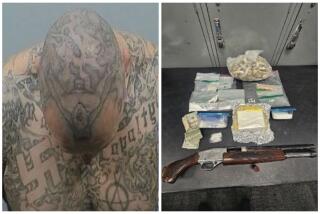Jury Is Told of Ruthless Aryan Gang
Outlining a two-decade span of prison killings, a federal prosecutor Tuesday described the Aryan Brotherhood as a small but ruthlessly committed prison gang that used murder to control vast inmate populations and enforce a rigid internal code.
The Brotherhood killed informers and rivals and the disrespectful, the prosecutor said, plus its own members who engaged in openly homosexual conduct or violated other gang codes. They killed by garrote and bludgeon and prison-made knife, he said, and ran a prison empire by writing letters in disappearing ink made from citrus juice or urine and smuggling messages from their cells in mop handles and peanut shells.
Although there are just 100 or so members, they are “particularly violent, disciplined, fearless, and committed to controlling and dominating the prison population” through terror, prosecutor Michael Emmick told jurors in his opening statement in federal court in Santa Ana, where four alleged leaders of the gang are being tried on racketeering charges.
The case, which is being heard under tight security and which could last most of this year, is part of one of the largest capital cases in U.S. history. It is designed to lop the head off a prison gang that authorities say began in San Quentin in the 1960s, as a way for white inmates to protect themselves against blacks, and has since grown into a wide-ranging criminal enterprise that includes drug-trafficking, extortion and gambling.
As part of the gang code, he said, members were expected to share drugs with one another, stay in physical shape, avenge attacks on fellow members, keep homosexual encounters discreet, and -- above all -- refuse to cooperate with authorities.
“The primary rule is never snitch, ever,” the prosecutor said.
The government, however, said it had managed to enlist dozens of informers to make its case against Barry “The Baron” Mills, T.D. “The Hulk” Bingham, Edgar “The Snail” Hevle and Christopher O. Gibson, all accused of taking part in murder and attempted murder as gang leaders.
H. Dean Steward, Mills’ defense attorney, told jurors the government’s case rested on the lies and fabrications of informers who were seeking personal gain, including payment of $8,000 in one instance, reduced sentences, better prison housing and small prison perks, like a bag of coffee or new shoes.
“This entire case is about these rats helping themselves,” Steward said.
Steward argued that many of the government’s witnesses had been housed together at a federal penitentiary in Colorado, a “snitch school” where they cobbled together their stories. He said it was absurd that the small Aryan Brotherhood could try to control “thousands and thousands of inmates.” The litany of killings and other crimes, he said, was actually a function of the “convict’s code” and not organized gang activity.
The prosecutor told jurors the gang’s code was “blood in, blood out,” meaning someone had to shed someone’s blood to gain membership and could leave only by dying. Hinting at the underworld lexicon that will be employed at trial, he said the phrase “in the hat” referred to someone condemned to die, while “rocking someone to sleep” referred to the practice of inducing a false sense of security in a target, the easier to kill him.
He said the gang was extremely selective in membership, picking inmates who were violent, trustworthy and willing to kill on command. He said the Brotherhood was characterized by “its fearlessness in its violence,” at times killing in full view of other inmates and guards. Often tattooed with shamrocks or Nazi emblems, members rarely called themselves the Aryan Brotherhood, referring to themselves instead as the Brand, the Rock or the Tip.
The prosecutor acknowledged that his witnesses had long, violent criminal histories, but said he would present them “warts and all.”
Though the indictment contains 32 counts of murder and attempted murder, prosecutors said they would focus on 15 of those alleged crimes, starting with Mills’ near-decapitation of an inmate in a bathroom stall in 1979 for cheating a fellow Brotherhood member on a drug deal.
In a 1989 case, a Brotherhood member named Arva Lee “Baby” Ray threw sugar packets and spat milk at Hevle in a prison cafeteria, causing a hush to fall over watching inmates. Hevle wanted Ray dead, the prosecutor said, but Mills and Bingham didn’t authorize his killing until it emerged that Ray had openly taken a male lover. When an overdose of potent heroin failed to kill Ray, the prosecutor said, Brotherhood assassins strangled him.
In August 1997, the prosecutor said, the leadership sent a message in invisible ink to members at the federal prison in Lewisburg, Pa. Rendered visible, the message read, “War with DC from TD,” which the prosecutor said referred to Bingham authorizing a race war against black inmates. Within hours, knives had been distributed, and two black inmates had been fatally stabbed.
Defense attorneys said Bingham’s note was merely a warning about an imminent race war, not an order to begin one.
In another case, the government alleges that Mafia don John Gotti paid the Brotherhood to kill an inmate he had scuffled with, though the man couldn’t be found. Steward, the defense attorney, characterized the Gotti contract as “a totally made-up episode.”
The case, which stems from a federal investigation begun in 1997, is being tried in federal court before U.S. District Judge David O. Carter. It is the first of three trials aimed at the Brotherhood leadership.
The second is scheduled to start this fall in Los Angeles. Of the 40 people indicted in all three trials, 20 have pleaded guilty; eight could face the death penalty if convicted, including Mills and Bingham; and eight others may still be charged with capital offenses.
The inmates, all of whom have bushy mustaches and eyeglasses, are being held at the Federal Correctional Institution at Terminal Island and are transported to court under tight security. During trial, their legs are kept in chains that are anchored to the floor out of the jurors’ sight.
As its first witness today, the government is expected to call Clifford Smith, a former high-ranking member of the gang who dropped out in 1984. The prosecutor said Smith had been targeted for death for refusing orders to kill the father of a friend.
In many instances, the inmate witnesses will also have their legs shackled while in the witness box.
More to Read
Sign up for Essential California
The most important California stories and recommendations in your inbox every morning.
You may occasionally receive promotional content from the Los Angeles Times.










